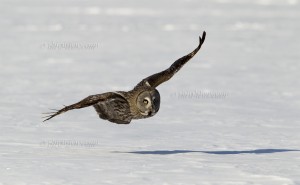 During a workshop near the northern part of the Baltic sea in Finland from 5th – 8th of April 2013 these excellent images of a hunting Great Grey Owl were shot.
During a workshop near the northern part of the Baltic sea in Finland from 5th – 8th of April 2013 these excellent images of a hunting Great Grey Owl were shot.
Wow, what an excellent bird. Just imagine, like this bird is sitting in a tall tree or on a barn roof concentrating to hunt on a vole on the floor which is 100 – 300 meters distant under 20 – 30 cm thick, insulating snow. This in spite of all kinds of ambient noise in the surroundings.
The Great Grey Owl, which we – the participants of the workshop – were able so observe and photograph on several mornings. This would by no means apply to all owls in that area. I guess we have been lucky now in early April. Most of other workshops run by Finnature – a tour operator from Oulu – take place in January/February for a period of 2 – 4 days. Since these owls do not accept feeding with dead mice, you are dependent on the mercy of the right places / times.
Not at least for aesthetic reasons photographing the hunting of voles in the winter landscape with a mix of forest and meadows is the best. Nevertheless, there is no guarantee of photographic results. The most important is, to locate the right place (and the right owl), then to find the owl in the landscape, then to be a patient person who can stand it – sometimes for 1 hour – at -10 ° Celsius to stand in the snow and hope that this bird is hungry enough for hunting. There is no time to waste, Great Grey Owls are nomadic and there is no knowing how long the owls would remain in the area for. Furthermore, you will need several attempts observing hunting activity and try to anticipate where the next hunting within an acceptable distance will happens.
In other words, not necessarily “a walk in the park” but also not witchcraft or rocket science!
Great Grey Owls are found in northern Europe, Northern America and Asia. This owl is one of the largest Owls of the world. When perched, they appear very bulky because of their dense, fluffy plumage. The almost human-like looking head and the prominent facial disk make the yellow eyes appear very bright but small. The german name “Bartkauz” is derived from a noticeable white “moustache” strip under the facial disk. Great Grey Owls are often flying with soft, slow wingbeats. They fly close to the ground you can enjoy in the gallery.
To cope with the growing demand for top shots of the rarer species of the Palearctic Bird-Lens is keen to enrich the range of pictures of birds you can find in the western palearctic. Trips to remote places like Finland in wintertime to capture images of rare birds of western palearctic were very successful. The nice images you find in that blog are only a first impression, what you will find in the gallery in the “Pictures Shop” very soon. Just give me a message, if I could serve you with an image needed before the new pictures are online.
Other successful shootings you can see under: www.bird-lens.com.